They say you are what you eat – but maybe you are what “they” eat.
The billions of bacteria residing in the human gut, called “microbiota,” make up an invisible world scientists are only beginning to explore. These bugs might exert far more influence on morbidity and mortality – and insurance medicine – than we ever suspected.
On a cellular level, we are only 10% human. Ten times as many bacteria live on our skin and in our gastrointestinal systems than we have human cells. The sum of the genetic codes carried in these bacterial species dwarf that of the human genome.
Some of our best friends are microbes; many play essential roles in supporting immune response to infection. Conversely, the wrong balance of bugs may contribute to chronic disorders such as allergies, asthma, diabetes, and even obesity.
Backed by Research
A well-known experiment includes transplanting fecal microbiota from an obese individual and from a thin person into two sets of laboratory mice.1 While all of these mice consumed the same low-fat high fiber diet, those with the obese person’s bugs gained weight, while the mice with the nonobese person’s microbiota remained slim.
Other studies suggest gut bacteria play a role in the production of enzymes, which aid digestion and the synthesis of vitamins, neurotransmitters, and other immune and metabolic signaling molecules. Scientists are beginning to appreciate that a delicate, mysterious ecosystem exists inside each of us. This community of beneficial bugs can keep us healthy or could collapse as we grow older, travel, and take certain drugs.
Researchers have discovered ways to harness microbiota to repair bad guts and fight worse diseases. Clostridium difficile, for example, is often an antibiotic-resistant infection and one of the most serious mortality and morbidity threats in hospitals.The reason? Common antibiotic treatments can kill “good” bacteria in a patient’s bowel, leaving the individual vulnerable to infection and to this particularly aggressive form of colitis. A set of microbes, distilled from a healthy donor and condensed into a pill, can return those missing “good” bugs and enable patients to fight off this hospital-borne infection.
Game-Changing Potential
Microbes could keep other varieties of pathogens from infecting us by making the gut environment inhospitable to foreign invaders. A National Institutes of Health (U.S.) initiative, the Human Microbiome Project, is identifying the microorganisms in healthy and diseased humans.
For insurers, the implications are vast. New insights into how these bugs keep us safe or make us sick will help shape the future of the industry. More than a century and a half ago, the poet Walt Whitman proclaimed, “I am large, I contain multitudes.” He had no idea.



